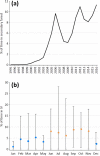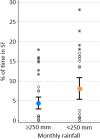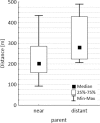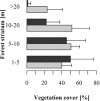Small Neotropical primates promote the natural regeneration of anthropogenically disturbed areas
- PMID: 31346187
- PMCID: PMC6658533
- DOI: 10.1038/s41598-019-46683-x
Small Neotropical primates promote the natural regeneration of anthropogenically disturbed areas
Erratum in
-
Author Correction: Small Neotropical primates promote the natural regeneration of anthropogenically disturbed areas.Sci Rep. 2020 Jan 27;10(1):1509. doi: 10.1038/s41598-020-57958-z. Sci Rep. 2020. PMID: 31988299 Free PMC article.
Abstract
Increasingly large proportions of tropical forests are anthropogenically disturbed. Where natural regeneration is possible at all, it requires the input of plant seeds through seed dispersal from the forest matrix. Zoochorous seed dispersal - the major seed dispersal mode for woody plants in tropical forests - is particularly important for natural regeneration. In this study, covering a period of more than 20 years, we show that small New World primates, the tamarins Saguinus mystax and Leontocebus nigrifrons, increase their use of an anthropogenically disturbed area over time and disperse seeds from primary forest tree species into this area. Through monitoring the fate of seeds and through parentage analyses of seedlings of the legume Parkia panurensis from the disturbed area and candidate parents from the primary forest matrix, we show that tamarin seed dispersal is effective and contributes to the natural regeneration of the disturbed area.
Conflict of interest statement
The authors declare no competing interests.
Figures






 : location of the field station;
: location of the field station;  : secondary forest area. (a) 2011; (b) 2018. Source: Google Earth.
: secondary forest area. (a) 2011; (b) 2018. Source: Google Earth.

References
-
- Aide TM, et al. Deforestation and reforestation of Latin America and the Caribbean (2001–2010) Biotropica. 2013;45:262–271. doi: 10.1111/j.1744-7429.2012.00908.x. - DOI
-
- Chazdon, R. L. Secondary growth. The promise of tropical forest regeneration in an age of deforestation. (University of Chicago Press, 2014).
-
- Wunderle JM., Jr. The role of animal seed dispersal in accelerating native forest regeneration on degraded tropical lands. Forest Ecology and Management. 1997;99:223–235. doi: 10.1016/S0378-1127(97)00208-9. - DOI
Publication types
MeSH terms
LinkOut - more resources
Full Text Sources

